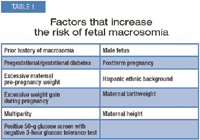Using U/S to assess fetal macrosomia: Are we there yet?
When it comes to detecting macrosomia, ultrasound has its strengths and limitations. Two experts examine the research and offer practical advice.
When a 33-year-old we'll call Janet Freeman (G1, P0) presented at 38 weeks' gestation, we suspected that her fetus was larger than normal for her dates. Ultrasound indicated an estimated fetal weight of 4,000 g, at the 95th percentile. Her antepartum course was uncomplicated, except for a 1-hour glucose screening test, which was elevated at 140 mg/dL at 28 weeks' gestation, with subsequent normal 3-hour glucose tolerance test. How should this patient be counseled and managed?
Before answering that question, let's briefly review some of the basics, including
Defining fetal macrosomia
In 1996, about 10% of liveborn infants weighed more than 4,000 g, and 1.5% weighed more than 4,500 g.3,4 Given trends in obesity in the United States, it's surprising to find that the prevalence of macrosomia has actually decreased significantly since then. The prevalence of newborns weighing at least 4,000 g decreased by 10% from 1996 (10.2%) to 2002 (9.2%) and decreased by 19% for newborns with weights more than 5,000 g (from 0.16% to 0.13%, over the same time).4 This decline may be due to several factors, including routine testing for gestational diabetes, the increasing rates of multiple gestations, preterm deliveries, earlier and more routine inductions, and scheduled repeat cesarean deliveries.
Reviewing the causes and complications

